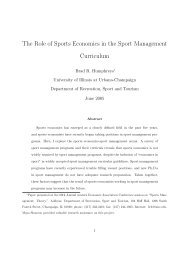Create successful ePaper yourself
Turn your PDF publications into a flip-book with our unique Google optimized e-Paper software.
The Right<br />
Way to<br />
Warm Up<br />
By R. Givens<br />
Randi Givens is the author of<br />
The Eight Ball Bible: A Guide<br />
to Bar Table Play and editor<br />
of Banking with the Beard by<br />
Freddy Bentivegna.<br />
24<br />
P&BÊA ugustÊ2009<br />
Once you find yourself in the<br />
competitive arena, there are a few<br />
time-honored preparations that<br />
will help you deal with the added pressure.<br />
First, don’t attempt to warm-up just before a match.<br />
Tournaments seldom allow enough warm-up<br />
time to get things rolling well, so prepare yourself<br />
beforehand. Serious competitors should already<br />
have their arm loosened up before they come near<br />
the match table. Winners warm up before matches<br />
(well away from the tournament location if possible).<br />
Remember you’re there to warm up your arm and<br />
get to know the equipment. Instead of floundering<br />
until you hit enough balls (by which time you may<br />
be eliminated); you want to be prepared to get<br />
off at maximum speed in your first inning. Tough<br />
adversaries go full throttle from the first shot.<br />
Warming up is much different than practice.<br />
Instead of using your limited warm up time trying<br />
to groove your stroke, be prepared and spend the<br />
time reading the table. Cut angles never change<br />
so focus on learning how the table plays.<br />
Draw the cue ball different distances to check the<br />
speed of the cloth. See how much force it takes<br />
8-Ball Bash!<br />
to drive the cue ball around the table. Measure<br />
the stroke force needed to go one rail cross table<br />
and one rail up and down. Check the pockets<br />
for their cheat limit, how tight they are. See how<br />
much a ball is thrown by english. Look for table<br />
rolls. If the table has a bend one way or the other,<br />
you need to know before it costs you a game.<br />
If you will lag for the break, measure that shot well.<br />
Bank a few shots to see whether the cushions<br />
are playing long or short or right on the money.<br />
Pay attention to rebound angles when moving the<br />
cue ball around the table. See how the cushions<br />
react to english, force and angle. Look for any<br />
strange returns that may indicate a dead rail.<br />
Check the resiliency of the balls. Knowing whether<br />
the balls react like dried out lima beans or play like<br />
quality Belgian balls with high restitution makes<br />
a big difference in shot selection. Knowing the<br />
elasticity of the balls is critical for fine control.<br />
Concentrate on using your playing<br />
rhythm while you read the table.<br />
A bit of focused warm-up time before your<br />
competitive match and you’ll be ready to<br />
put your best foot (and cue) forward!<br />
ÊÊÊÊwww .poolmag.comÊ

















